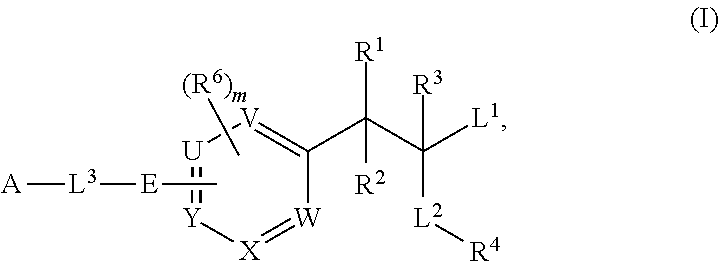Phenylalanine derivatives and their use as non-peptide glp-1 receptor modulators
- Summary
- Abstract
- Description
- Claims
- Application Information
AI Technical Summary
Benefits of technology
Problems solved by technology
Method used
Image
Examples
example 1
3-{4-[5-(4-tert-Butoxycarbonylamino-phenyl)-[1,2,4]oxadiazol-3-yl]-3-fluoro-phenyl}-2-[(5-p-tolyl-furan-2-carbonyl)-amino]-propionic acid 6
[0338]
[0339]Step A. 4-Bromomethyl-2-fluoro-benzonitrile. To a solution of 2-fluoro-4-methylbenzonitrile (135.0 g, 1.0 mol) and BPO (13.5 g, 0.06 mol) in CHCl3 (800 mL) was added NBS (178.0 g, 1 mol) in three portions. The mixture was stirred for 4 hrs at reflux. After cooling to room temperature, the solution was poured to a saturated aqueous NaHCO3 and extracted with CH2Cl2 (3×300 mL). The combined organic layer was washed with brine, dried over anhydrous Na2SO4, and concentrated under reduced pressure to give the title compound (232 g) as a yellow viscous liquid, which was used directly in the next step without further purification.
[0340]Step B. 2-Amino-3-(4-cyano-3-fluoro-phenyl)-propionic acid ethyl ester. In a 1.0 L flask, a mixture of ethyl 2-(diphenylmethyleneamino)acetate (267 g, 1.0 mol) and the catalyst Bu4NBr (32 g, 0.1 mol) in CH3CN (...
example 2
3-{4-[5-(4-tert-Butoxycarbonylamino-phenyl)-[1,2,4]oxadiazol-3-yl]-3-fluoro-phenyl}-2-[(6-p-tolyl-pyridine-2-carbonyl)-amino]-propionic acid 32
[0347]
[0348]Step A. 6-p-Tolyl-pyridine-2-carboxylic acid. A mixture of 6-bromo-pyridine-2-carboxylic acid (202 mg, 1 mmol), 4-methylphenylboronic acid (163 mg, 1.2 mmol), and Pd(PPh3)4 (25 mg) in saturated aq. NaHCO3 solution (3 mL) and DME (3 mL) was irradiated in a microwave on a Biotage Smith Synthesizer at 100° C. for 2 hrs. TLC showed the reaction was completed. The mixture was filtered and washed with water (2×50 mL) and ether (2×50 mL). The organic and aqueous layers were separated. The pH of the aqueous portion was adjusted to about 1 with 1 N aq. HCl solution. The aqueous layer was then extracted with ethyl acetate (3×60 mL). The combined organic layer was dried over anhydrous sodium sulfate and filtered. The solvent was evaporated to give the title compound (191 mg, 90% yield).
[0349]Step B. 3-{4-[5-(4-tert-Butoxycarbonylamino-phenyl...
example 3
3-{4-[5-(4-tert-Butoxycarbonylamino-phenyl)-[1,2,4]oxadiazol-3-yl]-3-fluoro-phenyl}-2-[(5-m-tolyl-furan-2-carbonyl)-amino]-propionic acid
[0351]
[0352]Step A. 5-m-Tolylfuran-2-carboxylic acid. To a solution of 3-methylphenylboronic acid (0.136 g, 2 mmol), methyl 5-bromofuran-2-carboxylate (0.408 g, 2 mmol), and Na2CO3 (0.424 g, 4 mmol) in propan-2-ol (5 mL) was added Pd(PPh3)2Cl2 (0.07 g) under Nitrogen. The reaction mixture was stirred at reflux for 5 hrs, and then concentrated under reduced pressure. The residue was extracted with EtOAc (2×5 mL). The combined organic layers were washed with brine and concentrated. The crude was purified on a flash column chromatograph (PE / EtOAc, 20 / 1) to give a colorless oil. The oil was treated with 1N NaOH (0.5 mL) in methanol (2 mL) for 0.5-1 hr at room temperature. The solution was then concentrated, acidified with 5N HCl to pH 2-3, and filtered to afford 5-m-tolylfuran-2-carboxylic acid (0.279 g, 69.1% yield for the last two step) as a grey sol...
PUM
| Property | Measurement | Unit |
|---|---|---|
| Molar density | aaaaa | aaaaa |
| Molar density | aaaaa | aaaaa |
| Molar density | aaaaa | aaaaa |
Abstract
Description
Claims
Application Information
 Login to View More
Login to View More - R&D
- Intellectual Property
- Life Sciences
- Materials
- Tech Scout
- Unparalleled Data Quality
- Higher Quality Content
- 60% Fewer Hallucinations
Browse by: Latest US Patents, China's latest patents, Technical Efficacy Thesaurus, Application Domain, Technology Topic, Popular Technical Reports.
© 2025 PatSnap. All rights reserved.Legal|Privacy policy|Modern Slavery Act Transparency Statement|Sitemap|About US| Contact US: help@patsnap.com



